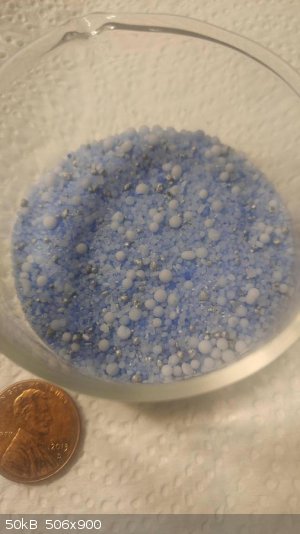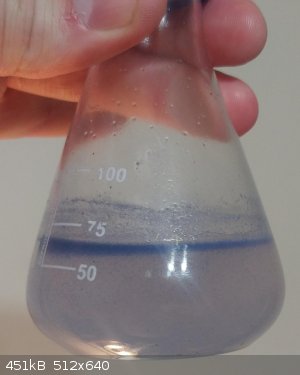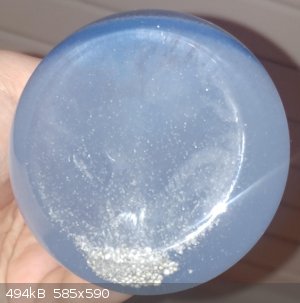SuperOxide
Hazard to Others
  
Posts: 486
Registered: 24-7-2019
Location: Devils Anus
Member Is Offline
|
|
Looking for best way to separate NaOH from NaNO3, Na2CO3 and Aluminium
A while ago I saw some sodium hydroxide based "grease clog dissolver" for a decent price and ended up buying a few bottles of it (2lb in each, and it
was a pretty decent price). The label didn't list anything other than the NaOH, and by shaking it around I could tell that the contents were granular
(instead of aqueous).
Fast forward in time, and I finally get around to opening it up and to my surprise, its bright blue with some dark dots... So it's clearly not just
NaOH. Here's a picture:

(high res img)
I then dissolved some of it in water, and at first the water turned blue (as expected), but by the next morning, the solution was actually pretty
clear, but there was blue particulate floating on the surface, as seen below:

(high res img)
and black/silver particulates sitting at the bottom of the solution:

(high res img)
So I did what I should have done before even buying this product - I looked up the Zep Crystal Heat Drain Opener MSDS document, and can see it's contains the following:
Sodium hydroxide - 30-40% (by weight)
Sodium nitrate - 20-30%
Sodium carbonate - 5-10%
Aluminium granules - 5-10%
I think the fact that it has aluminium granules in it means I can't just add water, because the NaOH will react with it making sodium aluminate and
hydrogen.
I did look up the solubility for the hydroxide/nitrate/carbonate compounds to see if there's some solvent that could be used to pull out the hydroxide
and leave the others but nothing really stood out as ideal.
Looking at the picture, I can see that there are some actual prills among the granules, though I'm not sure which is which. I will probably try to
sift those out and see if they are the sodium hydroxide (if its NaOH it'll be exothermic, if it's NaNO3 it'll be endothermic), but even if
they are, they're covered in the powder from the other compounds and thus will need some cleaning anyways (likely with a solvent that I have yet to
decide on).
Also, none of the 4 compounds listed in the MSDS are blue, so I'm not sure where the blue color is coming from or if it will interfere later.
If anyone has any recommendations, that would be appreciated. Or if anyone has actually purchased the same (or similar) product and had to do the same
thing.
Thanks!
[Edited on 4-11-2020 by SuperOxide]
|
|
|
DraconicAcid
International Hazard
    
Posts: 4334
Registered: 1-2-2013
Location: The tiniest college campus ever....
Member Is Offline
Mood: Semi-victorious.
|
|
I suspect the large prills are the sodium hydroxide.
Please remember: "Filtrate" is not a verb.
Write up your lab reports the way your instructor wants them, not the way your ex-instructor wants them.
|
|
|
itsallgoodjames
Hazard to Others
  
Posts: 276
Registered: 31-8-2020
Location: America Lite
Member Is Offline
|
|
^ this. Filtering through a medium-coarse kitchen strainer would probably give some pretty decent quality NaOH
Nuclear physics is neat. It's a shame it's so regulated...
Now that I think about it, that's probably a good thing. Still annoying though.
|
|
|
MidLifeChemist
Hazard to Others
  
Posts: 192
Registered: 4-7-2019
Location: West Coast USA
Member Is Offline
Mood: precipitatory
|
|
Quote: Originally posted by SuperOxide  |
but even if they are, they're covered in the powder from the other compounds and thus will need some cleaning anyways (likely with a solvent that I
have yet to decide on).
Thanks!
|
I imagine the powder will dissolve much faster than the prills themselves. So you might be able to very quickly rinse the powder off the prills with a
small amount of water, it will decrease your yield but should improve the purity, assuming the prills are NaOH.
[Edited on 11/4/2020 by MidLifeChemist]
|
|
|